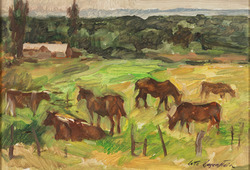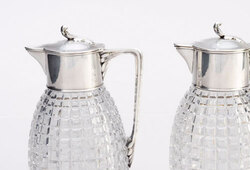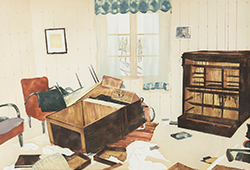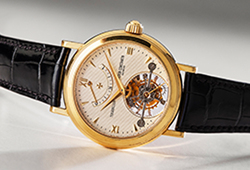John Chamberlain
"Untitled" from: "Salty Water/Fan mail"
Monoprint, 1988, signed in pencil, published by Novak Graphics, Toronto, and with their blindstamp. S: 240 x 80 cm (printed on two joined sheets as issued).
More information
From a series of 24 unique monoprints.
Artist
John Chamberlain is the artist who profoundly transformed abstract expressionism from two-dimensional painting to physical objects. His guiding principles during creation were "fit" and "choice"—two parameters that, combined with Chamberlain's intuitive sense, turned metal car parts into groundbreaking artworks.
Towards the end of the 1950s, Chamberlain began creating using sheet metals and car parts, a material that was hardly sparce or expensive following the aftermath of the Second World War in America. Using these painted metal sheets, sometimes incorporating easily recognizable parts from junked cars, Chamberlain crafted both freestanding floor sculptures and wall-mounted sculptures. In 1960 Chamberlain had his first proper gallery exhibition at the legendary Martha Jackson. Despite hardly selling anything, the critics took a liking to him and included him in the exhibition ‘The Art of Assemblage’ at the Museum of Modern Art in New York the following year.
After having exhibited at Leo Castelli several times during the first half of the 1960s, participating in the Venice and São Paulo Biennale, Chamberlain began in 1966 to experiment with different materials than metal, opting rather for white shifted materials such as plexiglass, foam rubber, and paper. During this 7 yearlong experimental period, the artist developed a harmonious relationship with his materials, one that he would carry with him for the remainder of his career. Yet it was his return to metal and car parts which became the start of the most highly appreciated part of his careet. His understanding for the importance of details and compositions (choice) and combinations (fit) of the chosen metal sheets created sculptures which combines motion with strength, sharp edges with flat surfaces. These are intuitive and expressionist objects that, despite their weight, possess movement and a significant degree of elegance. During the 1980s, when ”Le First” was created, Chamberlain worked with upwards and vertical lines.
Chamberlain advocated that the most important thing an artist has to understand is when to stop working. Chamberlain’s ability to identify the perfect moment to stop demonstrates a kind of humility towards the material and the task at hand. He did not strive to merge the various parts into a unified whole but aimed to let the selected components form a composition of shape and movement. This is why he never paints or otherwise modifies the parts after assembly and why the welded joints remain visible.
John Chamberlain is considered one of the most important artists of the postwar period. He revolutionized the sculpture genre, and his influence on younger generations of artists can hardly be overstated. His art continues to provoke and inspire!
Read more
- Get started with buying and selling
- Favourite items
- Save searches
Log in here



























